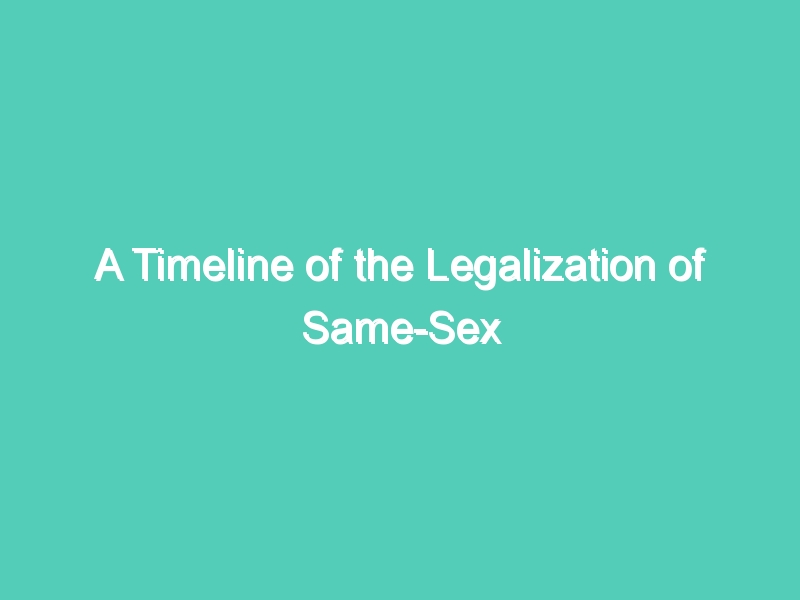The Timeline :
- 1970 – A same-sex couple in Minnesota applies for a marriage license. They are denied and their case goes to the state Supreme Court.
- 1973 – Maryland becomes the first state to ban same-sex marriage
- 1976 – a non-church sanctioned gay wedding makes news
- 1983 – ‘spousal’ rights of same-sex couples become an issue – a lesbian couple is confronted with the spousal rights issue when one of them is in a car accident and the other is denied the right to care for her.
- 1984 – Berkeley, CA passes the nation’s first domestic partnership law
- 1987 – first mass same-sex wedding ceremony – occurs on the National Mall – nearly 2000 same-sex marriages take place
- 1989 – court rulings in NY and CA define same-sex couples as families
- 1992 – same-sex employees begin to receive domestic partner benefits from Levi Strauss & Co. and the state of Mass.
- 1993 – the Hawaii Supreme Court rules that same-sex marriages cannot be denied unless there is a “compelling” reason to do so – Hawaii legislators respond by passing an amendment to ban gay marriage
- 1995 – Utah governor signs a state DOMA statute into law
- 1996 – President Clinton signs the federal DOMA
- 1997 – Hawaii becomes the first state to offer domestic partnership benefits to same sex couples
- 1998 – Alaskan and Hawaiian voters approve state constitutional bans on same-sex marriage
- 1999 – Vermont’s Supreme Court rules that same-sex couples must receive the same benefits and protections as any other married couple under the Vermont Constitution
- 2000 – the Central Conference of American Rabbis agrees to allow religious ceremonies for same-sex couples while Vermont becomes the first state to pass a law granting the full benefits of marriage to same-sex couples. Nebraska voters approve a state constitutional ban on same-sex marriage
- 2002 – Nevada votes to approve a state constitutional ban on same-sex marriage
- 2003 – A proposed amendment to the federal Constitution is introduced to the House of Representatives. It would define marriage as only between a man and a woman. The U.S. Supreme Court decides Lawrence v. Texas, striking down sodomy law and enshrining a broad constitutional right to sexual privacy. California passes a domestic partnership law which provides same-sex partners with almost all the rights and responsibilities as spouses in civil marriages. President Bush states that he wants marriage reserves for heterosexuals and the Massachusetts Supreme Court hands down a decision that makes Massachusetts the first state to legalize gay marriage.
- 2004 – The city of San Francisco begins marrying same-sex couples in an open challenge to CA law and New Mexico begins issuing marriage licenses to same-sex couples as their law does not mention gender. Portland, Oregon also begins issuing marriage licenses to same-sex couples. A poll taken by the Washington Post shows that 51% of the country favors allowing same-sex couples to form civil unions. While San Francisco is told to halt same-sex unions, Oregon takes the more drastic step of halting all marriages until the state decides who can and cannot wed. The proposed constitutional amendment with the same-sex ban dies in the U.S. Senate after testimony against it from conservative politicians. Missouri votes to ban same-sex marriage. Washington state says yes to same-sex marriage in a court decision while the California Supreme Court voids same-sex marriages. Several states pass initiatives to ban same-sex marriages.
- 2005 – In New York, a state judge calls the state ban on same-sex marriage illegal. California’s legislature attempts to pass a law legalizing same-sex unions but it is vetoed by the governor. Connecticut becomes the second state to approve same-sex unions.
- 2006 – The New Jersey Supreme Court orders the legislature to recognize same-sex unions.
- 2008 – California’s Supreme Court overturns the ban on gay marriage. This leads to California voters approving a constitutional ban on same-sex marriage. Florida and Arizona voters do the same.
- 2009 – The Iowa Supreme Court overturns the state ban on same-sex marriage. Vermont’s legislature legalizes same-sex marriages. Maine and New Hampshire follow suit, though Maine voters later repeal the state law allowing same-sex marriage.
- 2010 – California’s voter-passed ban on same-sex marriage from 2008, known as Prop 8, is declared unconstitutional.
- 2011 – President Obama declares DOMA unconstitutional. New York legalizes same-sex marriage.
- 2012 – The Ninth Circuit finds Prop 8 unconstitutional. Washington state, Maine, and Maryland legalize same-sex marriage by popular vote.
- 2013 – Rhode Island, Delaware, Minnesota, New Jersey, Hawaii, Illinois, and New Mexico legalize same-sex marriage. The U.S. Supreme Court finds Section 3 of DOMA unconstitutional. It also decides the Prop 8 defenders lack standing, clearing the way for same-sex unions to be legalized in California. The IRS recognizes same-sex married couples. Utah’s same-sex marriage ban is found unconstitutional.
- 2014 – Oregon, Pennsylvania, Kansas, and South Carolina legalize same-sex marriage. The Presbyterian church votes to allow same-sex ceremonies. The U.S. Supreme Court decides a case that allows for same-sex marriage in 5 states (VA, OK, UT, WI, and IN) but declines to make a blanket statement for all states.
- 2015 – The U.S. Supreme Court makes same-sex marriages legal in all 50 states in Obergefell v. Hodges.
It is only fitting to end this timeline with the following quote from that decision:
“No union is more profound than marriage, for it embodies the highest ideals of love, fidelity, devotion, sacrifice, and family. In forming a marital union, two people become something greater than once they were. As some of the petitioners in these cases demonstrate, marriage embodies a love that may endure even past death. It would misunderstand these men and women to say they disrespect the idea of marriage. Their plea is that they do respect it, respect it so deeply that they seek to find its fulfillment for themselves. Their hope is not to be condemned to live in loneliness, excluded from one of civilization’s oldest institutions. They ask for equal dignity in the eyes of the law. The Constitution grants them that right.”
Source : https://guides.ll.georgetown.edu/c.php?g=592919&p=4182201



